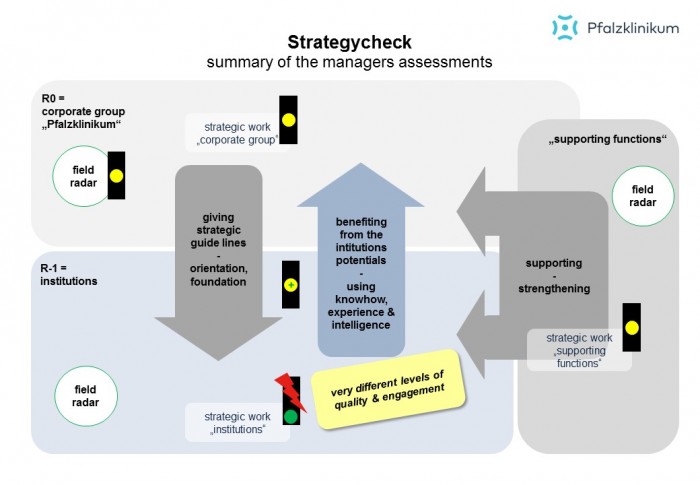A health and welfare institution’s unique features are no longer sufficient to grant its future success. Pfalzklinikum, service provider for mental health, has analysed and standardised the processes of strategy development in its individual departments. As a result new ideas and business models are developing, having changed the strategic positioning of the clinic group.
Pfalzklinikum is a service provider for mental health in the Palatinate in Southwest Germany and offers a wide-ranging network of mental health services with various clinics and community-based service sectors. The individual locations and business segments have developed positively in recent years. The reason for this are effective strategies to provide better treatment and support offers, to stand out in the competition with other providers and, thus, to promote the sustainability of the group.
Strategy development step-by-step
Despite these successes and the increasing level of group and division strategies, it became obvious that the respective strategies worked only in certain sections of the group, that there were difficulties when implementing the strategies and that the different demands of these individual divisions complicated the strategy work itself. In order to revise its strategy work Pfalzklinikum developed a multi-step procedure; in cooperation with an external consultant it identified four main targets:
- Improve the executives’ common strategy comprehension and anchor the use of the agreed strategy tools in the management process as a binding element.
- Take account of the particularities and the partly extremely different environmental dynamics of the divisions and simultaneously develop a common mode and framework for the strategy work.
- Network the steps of strategy development and implementation within the clinics and across the institutions so that a convincing overall picture and efficient reference points for the development are created.
- Include employees and executives in the strategy development procedure in such a way that they accept the result as “their” result and implement it enthusiastically.
Phase 1: Strategy check
As a first measure, a strategy check focused on the process of strategy development, on obstacles and difficulties encountered when implementing them and the systemic demands to effectively interlink approximately ten strategies of the various divisions as well as of the whole institution. It was not external consultants but the clinic’s executives who were consulted to assess the situation as experts (see illustration). By means of an online questionnaire and complementary in-depth interviews with the executives the external consultant worked out a joint assessment of the efficiency of the strategy work. The results of the survey and the interviews showed that:
- The strategy work language should be easily understandable and linked to terms from the employees‘ world. The specialised management language hinders strategic discussions when executives and employees experience them as culturally unfamiliar, do not completely understand and grasp them or even reject them entirely.
- Although a clearly defined and uniform strategy procedure contributed to comprehensibility in the past, the specific conditions of the single institutions have to be better depicted and considered. So the strategy work in community-based services for example needs different foci, time intervals and settings than that in neurology or forensic psychiatry.
- The strategy implementation in daily life can be supported efficiently by forging a better link to operative topics and instruments.
Phase 2: Strategy work 2.0
Based on the results of the survey and interviews, the existing instruments and tools were linguistically revised, simplified and purged the existing instruments in order to provide optimised support for the executives in their strategy work. Instruments and tools were designed in a more modular structure and templates were freed from too detailed specifications. The respective management teams are, thus, able to decide on their own what subjects at what point of time have to be examined more closely and what strategic dimensions they have to be assigned to. In this way the complexity of the strategy tools has been deliberately increased to achieve sound statements because they are sufficiently specific. At the same time there is a group-wide uniform basic logic of the process and of all instruments.
In order to grant a better development and control of the overall strategic work process as well in its interactions the management board defined a chronological sequence of the strategy development in the course of the year. So an iterative process from the overall to the divisional and the functional strategies was depicted and synchronised with the process of budgeting or more precisely economic planning. This process is also structured rather modularly and diversely so that the individual institutions can also select a different interval for the strategy work without endangering the overall process.
Phase 3: Strategy processes in the institutions
In order to implement the strategies successfully, to additionally validate and further refine the process, an external consultant exemplarily accompanied the strategy work in some institutions before they were expanded to other divisions. One of these institutions was Pfalzinstitut, Pfalzklinikum’s clinic for child and adolescent psychiatry. The strategy development resulted in a modified business model that is now being practically implemented.
The Clinic for Forensic Psychiatry thoroughly examined the strategy process by means of the revised classification. Thereby it took into account the requirements altered due to amended laws, a trend towards decreasing allocations through the courts and an internal change of leadership. This led to a clear orientation with regard to the challenges, the focused fields of action and a measure planning as well-coordinated with the support divisions.
In eight specialised departments at ten locations, the Betreuen-Fördern-Wohnen (care-foster-live) facility comprises the complete community-based mental health services offered by Pfalzklinikum. In contrast to hospitals this environment is not regulated so much by the state, so that these offers have to assert themselves in a competitive market against mostly independent charitable service providers and are, thus, subject to comparatively high dynamics. The management of the institution has further decentralised the process of strategy development. For this purpose the heads of the specialised departments worked out strategies with the agreed tools. In a workshop these were merged, measures were prioritised and requirements placed on the support units were formulated. Due to the manifold and extensive requirements the current development of the functional strategies of the support units shows a considerable need for negotiation and prioritisation within the Betreuen-Fördern-Wohnen facility.
Executives assume more responsibility
Due to the described optimisation steps, strategic discussions are led with a deeper understanding, especially of the importance of the environments relevant for Pfalzklinikum and of the systemic connections, for example between the divisional and functional strategies. Nevertheless the demands on the executives have not become fewer: While linguistic simplification and organisational questions consider the executives’ requirements, the executives, in exchange, take responsibility for the regular cycle and the depth of the strategy work and its concrete development – a task that has already become daily business for some executives.
Bernhard Koelber
Head of the Unit of Human Resources and Organization Development and Quality Management, Pfalzklinikum
Paul Bomke
CEO, Pfalzklinikum
Sven Lüngen
Deputy CEO, Malik Institute for Health Care Management
Source: f&w, edition 2/2017, page 136ff









